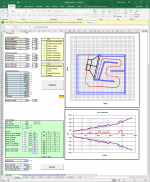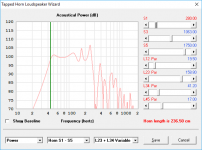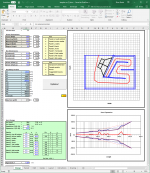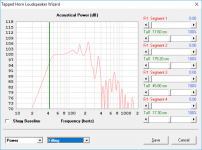Last time I checked, efficiency was a percentage.
It can be expressed that way as well, but the result is typically useless to most consumers. Expressing it in dB/W/M is much more consumer-friendly. It's a bit anachronistic to use "efficiency" anyway, because it varies with the speaker's impedance, which will change with frequency as the speaker's impedance will vary through its passband.
I feel dB/V/m is useless (or at least misleading) to most consumers as well and as sensitivity is also frequency dependant, why not just use dB/W/m, for consumers (and OP) sake?
I think that if you play that EDM that has strong 30 - 40 Hz content, you'll miss it regardless of the environment, as long as you know it's there to begin with. If you don't 50 Hz and up, all the way!Which makes me wonder, on a beach with heaps of noise from waves, will the low end be missed?
I feel dB/V/m is useless (or at least misleading) to most consumers as well
Nothing misleading about it. Use two subwoofers with the same passband and sensitivity, and they will produce the same SPL level at the same gain settings at the amp, up to the point that amp runs out of power.
OTOH, use two subwoofers with the same passband and efficiency but different nominal impedance ratings, and they will NOT produce the same SPL for the same gain settings at the amp. You will have to adjust the gain to match them.
Note: Designing a 50 Hz system also introduces another challenge - dealing with any bass signals below that 50 Hz Fb. An EQ or HP filter to deal with <50 Hz content may be required. Technically you'll also need HP filtering for a 40 Hz system, but there's a lot less music with <40 Hz content than there is with <50 Hz content.
I see that you have "moved on" from TH POCs onto these offset TL's etc. Do you find this new alignment more suitable for your aims? significantly smaller for a little sensitivity loss?
The offset TLs have a wider usable bandwidth and offer a smaller size, but less you lose sensitivity, as basically for these designs the sensitivity will be equivalent to or slightly more than using the drivers in vented box. The big advantage over a vented box would be less vent compression at higher SPL levels (due to the use of a larger vent). They're also easy to design and build. I've designed and built two and like the results.
I haven't really looked at simming the PA380 in the SS15 design, as the fold doesn't quite follow the corresponding Hornresp sim. If I was going to use the PA380 in an SS15-type fold, I'd use my workbook to come up with a fold that works for that particular driver. The THAM15 and TH18 designs are a bit closer to their sims, but I'd take the workbook approach anyway.
As an example, I've attached one possible SS15-type fold idea for the PA380. This uses a combination of 19mm and 12mm panels to keep the weight down but produce a box that's a bit more rigid than the original SS15. Bracing will still have to be used inside however to get the best results.
Attachments
There are some modern bandpass cabs like the superplanar and roar that can achieve the target too but you need to certify that you won't need wider band in a future because they have a big dip in the upper frequencies.
Those are also pretty large boxes...
if longer run-time is the main goal, and you're prepared to give up 10 Hz, the SS15 (using the driver that it was designed around) is probably the best approach.
Otherwise compromises will have to be made.
A redesigned SS15 fold can get closer to 40 Hz, but overall SPL will be reduced if box size is kept the same. Car audio amps are optimized around 4 ohm or 2 ohm loads, so connecting two 8 ohm boxes in parallel to the amp could be the best approach. It's just a matter now of deciding what boxes to use
Note: Designing a 50 Hz system also introduces another challenge - dealing with any bass signals below that 50 Hz Fb. An EQ or HP filter to deal with <50 Hz content may be required. Technically you'll also need HP filtering for a 40 Hz system, but there's a lot less music with <40 Hz content than there is with <50 Hz content.
Brian
I just run a quick sim with the Hornresp parameters from your spreadsheet example and it came up with a fourth order high pass filter frequency of 35hz.
Brian, thank you so much for the sims. I looked at everything side by side on a spreadsheet, got a tape measure out to visualize the dimensions of the different designs, I think my conclusion is that - if a SS15 with PA380 can be "modified" to do an honest 40Hz (just like your offset TL), and still have a 98db sensitivity (compared to the 95db of the OS TL) it would be worth it.
My rationale is that SS15 is about twice of your OSTL in size, so if the "40Hz modded SS15" can be 3db more sensitive than the OSTL, that means I can have the same output, in the same size, with just 1 driver. Of course then I don't get the 4ohm load, which just means that I should build 2! What that means is, with the same driver, the SS15 would be less cost and weight per db sensitivity gain, at similar size per db.
But then people say that TH designs really should be +6db compared to the BR for the same driver for it to be worth it right?
And if the dimensions are flexible, having it taller and thinner (less width), would be beneficial (depth doesn't matter much) because then with 2, I can use them to elevate the tops to ear level, and still strap them to a hitch tray.
Your OSTL got me wondering though, why would anyone build traditional ported boxes anymore, if you can just do a OSTL? the OSTL would be better in every category and just as easy to build?
My rationale is that SS15 is about twice of your OSTL in size, so if the "40Hz modded SS15" can be 3db more sensitive than the OSTL, that means I can have the same output, in the same size, with just 1 driver. Of course then I don't get the 4ohm load, which just means that I should build 2! What that means is, with the same driver, the SS15 would be less cost and weight per db sensitivity gain, at similar size per db.
But then people say that TH designs really should be +6db compared to the BR for the same driver for it to be worth it right?
And if the dimensions are flexible, having it taller and thinner (less width), would be beneficial (depth doesn't matter much) because then with 2, I can use them to elevate the tops to ear level, and still strap them to a hitch tray.
Your OSTL got me wondering though, why would anyone build traditional ported boxes anymore, if you can just do a OSTL? the OSTL would be better in every category and just as easy to build?
Brian, thank you so much for the sims. I looked at everything side by side on a spreadsheet, got a tape measure out to visualize the dimensions of the different designs, I think my conclusion is that - if a SS15 with PA380 can be "modified" to do an honest 40Hz (just like your offset TL), and still have a 98db sensitivity (compared to the 95db of the OS TL) it would be worth it.
It can be done. You basically give up sensitivity and peak passband output capability for extension. It's the decision I made when I designed and built the POC3 using the PA310 - I was more interested in seeing 40 Hz than the the peak output of the cabinet.
Note however that we are comparing a "known" design (the SS15 with the original driver, which I believe was the $180+ Kappalite 15) to a sim that's using a much cheaper driver, with a lower rated Xmax, and with a larger Le (published spec), the latter of which could affect what the passband really looks like.
My rationale is that SS15 is about twice of your OSTL in size, so if the "40Hz modded SS15" can be 3db more sensitive than the OSTL, that means I can have the same output, in the same size, with just 1 driver. Of course then I don't get the 4ohm load, which just means that I should build 2!
Yup, the question here is basically what size you're prepared to live with, for the bandwidth and SPL that you're trying to produce.
But then people say that TH designs really should be +6db compared to the BR for the same driver for it to be worth it right?
I don't agree. THs are a bit like 6th order BP alignments. You can trade efficiency for extension.
And if the dimensions are flexible, having it taller and thinner (less width), would be beneficial (depth doesn't matter much) because then with 2, I can use them to elevate the tops to ear level, and still strap them to a hitch tray.
The workbooks on my web page can be used to tweak the dimensions of the cab to fit a particular requirement. But yes, they can be made taller and thinner. The trick here is that in doing so you might have to use more ply sheets to build the cab, as you may not be able to cut all of the panels from one or two sheets.
Your OSTL got me wondering though, why would anyone build traditional ported boxes anymore, if you can just do a OSTL? the OSTL would be better in every category and just as easy to build?
It's a good question. The OSTL will likely be a little larger than a vented alignment for the same driver (due to the large vent), and the usable bandwidth will be smaller, but for subwoofer duty that's much less of a concern. I guess part of the problem is that there's a lot of crap floating around about TL design and what the goals of such a design should be.
Why not fit a 4-Ohm 18inch driver like a B-52 18-190X (150$ at Part Express) in a 6th order bandpass so you get 2.83V/104dB from > 40Hz?
That looks fantastic! I assume there are no established designs for this driver? can you suggest a box plan pretty please
what tops are you running for this rig? You mentioned 70hz crossover, but I suspect it'll work in your favour to cross higher
For now I'm just using a DIY box from a previous portable project using 4 efficient buyout 8" pro woofers per channel. its 100+db efficient and with a 35wx2 head unit they get loud enough above 70Hz and on a lawn mower battery last for like 10 hours!
Its such a rough design, it only sounds good outdoors. They are big and heavy but they get loud and gets the job done. At least for now.
Well, your narrow width target is probably going to be an issue for existing plans. But think of a HR118, X1 or the old LS1200 design (you can all google them). An X1 gets you even down to 36Hz but I'm not sure this driver would like that.
For just 1 I wouldn't need it to be slim. For the HR118 for example the dimensions would work for me, except that I'll need 2 people to move it, and I need to do some soul searching to think about that. But how would I know that this driver would work well in any of these boxes?
The HR118 is a relative easy load since it is a bandpass horn. The driver specs (if they are correct) seem to fall in the range and the motor looks strong enough to deal with 6th order bandpass designs. The LS1200 is also a fairly easy load but like I said the X1 might be too much for the driver. You could google for hornresp inputs of those designs and fill the driver parameters in.
Last edited:
After some reality check, I think for what I'm using it for, The SS15 or Brian's suggestions are a lot more practical. And I want to stick with established designs, just with the lower power driver, because I don't plan to give it more than 100w, and its a lot lighter on the wallet.
Right now I'm leaning towards the SS15/PA380 combo. If only thats 4ohm so I can just use 1. Cause 2 is really a lot to move around......
Right now I'm leaning towards the SS15/PA380 combo. If only thats 4ohm so I can just use 1. Cause 2 is really a lot to move around......
I think ultimately what I'm looking for is actually the 15" equiv of Brian's POC#3, using the PA380 - which is basically a taller, thinner version of the SS15 that goes down to 40Hz. I'm just a bit scared to deviate from plans done by the pros, and make a mess myself.....maybe the 44hz modded SS15 brian simmed will work well enough....
I think ultimately what I'm looking for is actually the 15" equiv of Brian's POC#3, using the PA380 - which is basically a taller, thinner version of the SS15 that goes down to 40Hz. I'm just a bit scared to deviate from plans done by the pros, and make a mess myself.....maybe the 44hz modded SS15 brian simmed will work well enough....
Note: Going with an "established design" means going with both the box layout and the driver or drivers that the box was designed for. The SS15 wasn't designed for the PA380 - it was designed for the Kappalite 3015LF.
Also, going with a box that is taller / thinner than the SS15 might mean you'll need more than one sheet of 4 x 8 ply to build it (assuming you stick to one sheet of ply - note that my modded version uses two sheets of different thickness).
Striking out on your own rather than sticking with an established plan can be a bit risky. But it can also be rewarding, if you do end up with exactly what you're looking for (or something close enough).
For comparison purposes, I tried to come up with something that's thinner and taller than the SS15, and reaches close to 40 Hz. This one just barely reaches 100dB/2.83V/1M
Attachments
Note: If you're looking to drive 100W into 8 ohms with a car audio amp, you've got to look for one that can drive at least 200W into 4 ohms, as peak power output will be halved as impedance is doubled. It shouldn't be different to find a decent cheap class D amp that can do that.
- Status
- This old topic is closed. If you want to reopen this topic, contact a moderator using the "Report Post" button.
- Home
- Loudspeakers
- Subwoofers
- SS15/THAM15/keystone/other for 12v outdoor party



